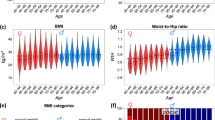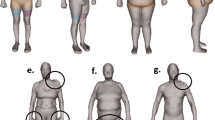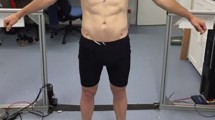Abstract
Objective: To test the hypothesis that overweight and central fat distribution make people look older and have poorer health.
Design: We asked 201 male and 161 female observers aged 28–67 y with body mass index (BMI) 17–45 kg/m2, to estimate the age of eight silhouette photographs of female volunteers with known BMI and waist and hips. Silhouette photographs were presented individually and grouped in three trios for analysis: trio A, each subject had waist to hip ratio=0.7, BMI for each subject was 22, 24, 29 kg/m2; trio B, each subject had BMI=22 kg/m2, waist to hip ratio for each subject was 0.66, 0.73, 0.99; and trio C, each subject had BMI=29 kg/m2, waist to hip ratio for each subject was 0.76, 0.88, 0.99. The observers were then asked to judge the likelihood of developing heart disease, health and longevity of the silhouettes which were presented in four pairs controlling either for BMI or waist to hip ratio.
Results: The age of a silhouette with BMI 22 kg/m2 was estimated to be 35 y, 24 kg/m2 to be 45 y, and 30 kg/m2 to be 55 y, when waist to hip ratio was matched at 0.7. When BMI was controlled at either 22 or 29 kg/m2, higher waist to hip ratio led to a greater age estimation. An increase from a 65 cm to 88 cm waist circumference led to an estimate of 25 y older. Narrow hips was also judged as older. The silhouettes judged the more likely to be healthy and live longer were those with the lower waist to hip ratio (by 70% observers), and the lower BMI (by 90% observers). Waist to hip ratio appeared less influential when BMI of the silhouettes was high. The observers’ own BMI, age or sex had little influences on their assessments of the age and health status of the silhouette photographs.
Conclusions: Using novel sets of silhouette photographs, it was shown that overweight or central fat distribution and narrow hips suggest a person is older and has poorer health: People with BMI 29.7 kg/m2 appear to be 15–18 y older than those with BMI 22.2 kg/m2, each extra cm on the waist makes women appear to look a year older, and progressively less healthy. BMI and age of the observers had little influences on the findings.
Sponsorship: Department of Human Nutrition Discretionary Funds, University of Glasgow (TSH), Chief Scottish Office, Scottish Home and Health Department (CEM) and Rank Foundation and Rank Prize funds (MEJL).
This is a preview of subscription content, access via your institution
Access options
Subscribe to this journal
Receive 12 print issues and online access
$259.00 per year
only $21.58 per issue
Buy this article
- Purchase on Springer Link
- Instant access to full article PDF
Prices may be subject to local taxes which are calculated during checkout
Similar content being viewed by others
Author information
Authors and Affiliations
Contributions
Guarantor:Dr TS Han.
Contributros: TS Han was responsible for data collection an analyses. All authors were involved in the design of the study and the writing of the paper.
Rights and permissions
About this article
Cite this article
Han, T., Morrison, C. & Lean, M. Age and health indications assessed by silhouette photographs. Eur J Clin Nutr 53, 606–611 (1999). https://doi.org/10.1038/sj.ejcn.1600816
Received:
Revised:
Accepted:
Published:
Issue Date:
DOI: https://doi.org/10.1038/sj.ejcn.1600816
Keywords
This article is cited by
-
Words matter: a qualitative investigation of which weight status terms are acceptable and motivate weight loss when used by health professionals
BMC Public Health (2011)
-
Dietary restraint and the mis-reporting of anthropometric measures by middle-aged adults
International Journal of Obesity (2004)



